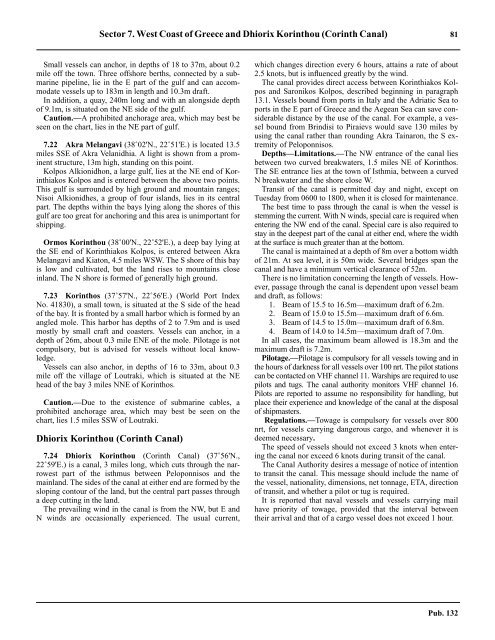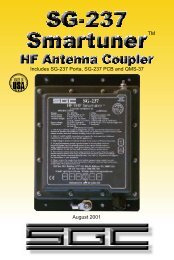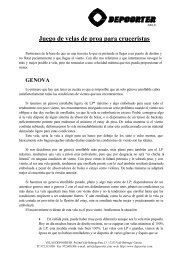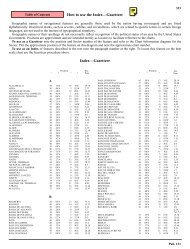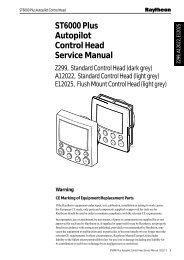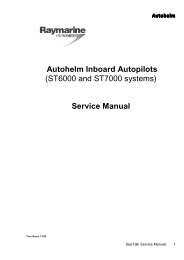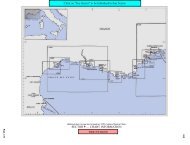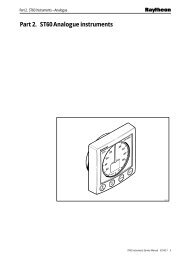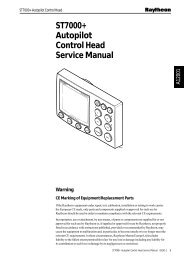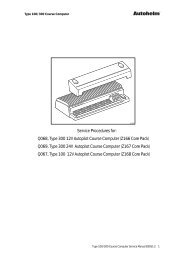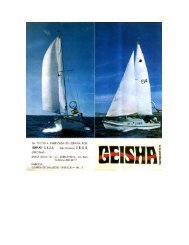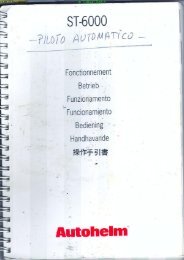80 Sector 7. West Coast of Greece and Dhiorix Korinthou (Corinth Canal)Akra Dhrepanon Lightof 5.2 to 8.5m alongside. Pilotage is compulsory for foreignvessels and pilots are provided from Patrai. The port monitorsVHF channels 12 and 21.7.18 Vessels can anchor, in a depth of 27m, mud, good holdingground, about 0.2 mile NW of the head of the pier.7.18 The town is prominent and stands on the seaward side of aflat hill. A conspicuous chimney is situated at a papermillstanding on the W side of the bay. Several jetties front thepapermill and are used by small coasters.7.18 Akra Likoporia (38˚08'N., 22˚29'E.), a low headland, isoverlooked by a prominent hill, 172m high, which stands nearthe shore. A light is shown from a prominent structure, 15mhigh, standing on this point.7.18 Between Ormos Aiyiou and the entrance to DhiorixKorinthou, 45 miles ESE, the S shore of the gulf is quite regular,with no significant indentations.7.18 Kiaton (38˚01'N., 22˚45'E.), a small town, is fronted by aharbor which is formed by two moles. There are depths of 2 to8m in this harbor which is used by coasters.7.19 Korinthiakos Kolpos—North side.—Akra Mornos(38˚22'N., 21˚52'E.), located 5.8 miles NE of Akra Andirrion,is low and sandy. This point is marked by a light and is the Sex-tremity of a swampy delta. Navpaktos, a small town, standsat the head of a bay 2.5 miles NW of the point. This town isfronted by a small craft harbor; vessels can anchor, in depths of13 to 24m, about 0.4 mile S of it.7.19 Akra Marathias, located 6 miles ENE of Akra Mornos, islow and wooded. Ifalos Marathias, a reef, has a least depth of3.8m and lies about 0.7 mile SE of this point.7.19 Nisis Trizonia lies 0.3 mile offshore 3.5 miles SE of AkraMarathias. This island can be easily identified by prominentreddish cliffs on its S and W sides. A light is shown from theNE side of the island and an islet lies 0.5 mile E of the SEextremity of the island.7.19 Akra Psaromita (38˚19'N., 22˚11'E.) is a steep-to point; theland behind it rises in three gradual slopes. A light is shownfrom a prominent structure, 9m high, standing on this point.7.19 Akra Andromakhi is located 9 miles E of Akra Psaromitaand the shore between is indented by several small coves. Theprominent village of Eratini is situated at the head of the Wcove. This point is bold, 93m high, and is marked by a light.Akra Psaromita Light7.20 Itea (38˚26'N., 22˚25'E.) (World Port Index No.41820), a small ore port, lies at the head of Kolpos Itea, a gulf,which is entered between Akra Andromakhi and Akra Makri-Nikolas, 8.8 miles ESE.7.20 Depths—Limitations.—Numerous islets, rocks, and shoalslie in the W part of the gulf and large or deep-draft vesselsshould keep clear of them and not attempt to pass through theconstricted and unmarked passages which lead between them.7.20 A general cargo pier fronts the town and has two berths withdepths of 6.3 to 7.5m alongside. Vessels up to 130m in lengthand 6m draft can be accommodated.7.20 Two bauxite ore berths, each consisting of short piers, liewithin Limin Itea and can accommodate vessels up to 40,000dwt, with a maximum draft of 10.5m.7.20 Pilotage.—Pilotage is compulsory for foreign vessels andGreek vessels of more than 500 tons. Pilots can be contacted onVHF channel 12 and board about 0.6 mile SE of the pier. In badweather, vessels should enter the bay at the head of the gulfwithout the pilot and anchor. Vessels should send an ETA 24 hoursin advance.7.20 Anchorage.—Anchorage can be taken in Limin Iteas, a bayat the head of the gulf. A good berth lies in a depth of 18m,mud, about 0.3 mile SW of the pier at Itea.7.20 A designated anchorage area for laid up vessels, the limits ofwhich may best be seen on the chart, occupies most of the SWpart of Limin Itea.7.20 Vessels may also anchor, in depths of 22 to 26m, within OrmosGalaxidhiou. This bay lies at the W side of the gulf and issheltered by a chain of islets and reefs which extends NEacross its entrance.7.20 Caution.—Several outfall pipelines lie in the vicinity of theport and may best be seen on the chart.7.21 Andikira (38˚22'N., 22˚38'E.), a small town, is situatedat the head of Andikiron Kolpos, an irregular bay enteredbetween Akra Pangalos, located 1.5 miles E of Akra Maki-Nikolas, and Akra Velanidhia, 8.7 miles ESE. Several isletsand shoals lie along the sides of the gulf, but the central part isdeep and clear. Pilotage is compulsory within the gulf. Pilotscan be contacted by VHF and board 1 mile off the coast in daylighthours only.7.21 At the head of the bay is Aspra Spitia Ore Terminal, an aerialloading stage for bauxite ore. It is 70m long, with mooring dolphinson either side and an alongside depth of 8.4m.Pub. 132
Sector 7. West Coast of Greece and Dhiorix Korinthou (Corinth Canal) 817.21 Small vessels can anchor, in depths of 18 to 37m, about 0.2mile off the town. Three offshore berths, connected by a submarinepipeline, lie in the E part of the gulf and can accommodatevessels up to 183m in length and 10.3m draft.7.21 In addition, a quay, 240m long and with an alongside depthof 9.1m, is situated on the NE side of the gulf.7.21 Caution.—A prohibited anchorage area, which may best beseen on the chart, lies in the NE part of gulf.7.22 Akra Melangavi (38˚02'N., 22˚51'E.) is located 13.5miles SSE of Akra Velanidhia. A light is shown from a prominentstructure, 13m high, standing on this point.7.22 Kolpos Alkionidhon, a large gulf, lies at the NE end of KorinthiakosKolpos and is entered between the above two points.This gulf is surrounded by high ground and mountain ranges;Nisoi Alkionidhes, a group of four islands, lies in its centralpart. The depths within the bays lying along the shores of thisgulf are too great for anchoring and this area is unimportant forshipping.7.22 Ormos Korinthou (38˚00'N., 22˚52'E.), a deep bay lying atthe SE end of Korinthiakos Kolpos, is entered between AkraMelangavi and Kiaton, 4.5 miles WSW. The S shore of this bayis low and cultivated, but the land rises to mountains closeinland. The N shore is formed of generally high ground.7.23 Korinthos (37˚57'N., 22˚56'E.) (World Port IndexNo. 41830), a small town, is situated at the S side of the headof the bay. It is fronted by a small harbor which is formed by anangled mole. This harbor has depths of 2 to 7.9m and is usedmostly by small craft and coasters. Vessels can anchor, in adepth of 26m, about 0.3 mile ENE of the mole. Pilotage is notcompulsory, but is advised for vessels without local knowledge.7.23 Vessels can also anchor, in depths of 16 to 33m, about 0.3mile off the village of Loutraki, which is situated at the NEhead of the bay 3 miles NNE of Korinthos.7.23 Caution.—Due to the existence of submarine cables, aprohibited anchorage area, which may best be seen on thechart, lies 1.5 miles SSW of Loutraki.Dhiorix Korinthou (Corinth Canal)7.24 Dhiorix Korinthou (Corinth Canal) (37˚56'N.,22˚59'E.) is a canal, 3 miles long, which cuts through the narrowestpart of the isthmus between Peloponnisos and themainland. The sides of the canal at either end are formed by thesloping contour of the land, but the central part passes througha deep cutting in the land.7.24 The prevailing wind in the canal is from the NW, but E andN winds are occasionally experienced. The usual current,which changes direction every 6 hours, attains a rate of about2.5 knots, but is influenced greatly by the wind.7.24 The canal provides direct access between Korinthiakos Kolposand Saronikos Kolpos, described beginning in paragraph13.1. Vessels bound from ports in Italy and the Adriatic Sea toports in the E part of Greece and the Aegean Sea can save considerabledistance by the use of the canal. For example, a vesselbound from Brindisi to Piraievs would save 130 miles byusing the canal rather than rounding Akra Tainaron, the S extremityof Peloponnisos.7.24 Depths—Limitations.—The NW entrance of the canal liesbetween two curved breakwaters, 1.5 miles NE of Korinthos.The SE entrance lies at the town of Isthmia, between a curvedN breakwater and the shore close W.7.24 Transit of the canal is permitted day and night, except onTuesday from 0600 to 1800, when it is closed for maintenance.7.24 The best time to pass through the canal is when the vessel isstemming the current. With N winds, special care is required whenentering the NW end of the canal. Special care is also required tostay in the deepest part of the canal at either end, where the widthat the surface is much greater than at the bottom.7.24 The canal is maintained at a depth of 8m over a bottom widthof 21m. At sea level, it is 50m wide. Several bridges span thecanal and have a minimum vertical clearance of 52m.7.24 There is no limitation concerning the length of vessels. However,passage through the canal is dependent upon vessel beamand draft, as follows:1. Beam of 15.5 to 16.5m—maximum draft of 6.2m.2. Beam of 15.0 to 15.5m—maximum draft of 6.6m.3. Beam of 14.5 to 15.0m—maximum draft of 6.8m.4. Beam of 14.0 to 14.5m—maximum draft of 7.0m.7.24 In all cases, the maximum beam allowed is 18.3m and themaximum draft is 7.2m.7.24 Pilotage.—Pilotage is compulsory for all vessels towing and inthe hours of darkness for all vessels over 100 nrt. The pilot stationscan be contacted on VHF channel 11. Warships are required to usepilots and tugs. The canal authority monitors VHF channel 16.Pilots are reported to assume no responsibility for handling, butplace their experience and knowledge of the canal at the disposalof shipmasters.7.24 Regulations.—Towage is compulsory for vessels over 800nrt, for vessels carrying dangerous cargo, and whenever it isdeemed necessary.7.24 The speed of vessels should not exceed 3 knots when enteringthe canal nor exceed 6 knots during transit of the canal.7.24 The Canal Authority desires a message of notice of intentionto transit the canal. This message should include the name ofthe vessel, nationality, dimensions, net tonnage, ETA, directionof transit, and whether a pilot or tug is required.7.24 It is reported that naval vessels and vessels carrying mailhave priority of towage, provided that the interval betweentheir arrival and that of a cargo vessel does not exceed 1 hour.Pub. 132
- Page 1 and 2:
PUB.132SAILING DIRECTIONS(ENROUTE)
- Page 3 and 4:
Preface0.0 Pub. 132, Sailing Direct
- Page 5 and 6:
ContentsHow to Keep this Book Corre
- Page 7 and 8:
0.0SECTOR LIMITS—PUB. 132Pub. 132
- Page 9:
AbbreviationsThe following abbrevia
- Page 13 and 14:
3SECTOR 1COAST OF LIBYA1.0 Plan.—
- Page 15 and 16:
Sector1.CoastofLibya 51.5 Pilotage.
- Page 17 and 18:
Sector1.CoastofLibya 71.12 Caution.
- Page 19 and 20:
Sector1.CoastofLibya 91.17 Jabal La
- Page 21 and 22:
Sector1.CoastofLibya 111.21 Tukrah
- Page 23:
Sector1.CoastofLibya 131.28 Aspect.
- Page 27 and 28:
17SECTOR 2COAST OF EGYPT2.0 Plan.
- Page 29 and 30:
Sector2.CoastofEgypt 19a depth of 2
- Page 31 and 32:
Sector2.CoastofEgypt 212.10 Several
- Page 33 and 34:
Sector2.CoastofEgypt 232.17 Local v
- Page 35:
Sector2.CoastofEgypt 25high, stands
- Page 39 and 40: 29SECTOR 3COASTS OF ISRAEL, LEBANON
- Page 41 and 42: Sector 3. Coasts of Israel, Lebanon
- Page 43 and 44: Sector 3. Coasts of Israel, Lebanon
- Page 45 and 46: Sector 3. Coasts of Israel, Lebanon
- Page 47 and 48: Sector 3. Coasts of Israel, Lebanon
- Page 49: 4.CyprusPub. 1324.0Additional chart
- Page 52 and 53: 42 Sector4.Cyprusthe village. Ancho
- Page 54 and 55: 44 Sector4.Cyprus4.10 A conspicuous
- Page 56 and 57: 46 Sector4.Cyprus4.18 Kakoskaliou I
- Page 59 and 60: 49SECTOR 5SOUTH COAST OF TURKEY—K
- Page 61 and 62: Sector 5. South Coast of Turkey—K
- Page 63 and 64: Sector 5. South Coast of Turkey—K
- Page 65 and 66: Sector 5. South Coast of Turkey—K
- Page 67: Sector 5. South Coast of Turkey—K
- Page 71 and 72: 61SECTOR 6RODHOS (RHODES), NISOS KA
- Page 73 and 74: Sector 6. Rodhos (Rhodes), Nisos Ka
- Page 75 and 76: Sector 6. Rodhos (Rhodes), Nisos Ka
- Page 77 and 78: Sector 6. Rodhos (Rhodes), Nisos Ka
- Page 79 and 80: Sector 6. Rodhos (Rhodes), Nisos Ka
- Page 81 and 82: Sector 6. Rodhos (Rhodes), Nisos Ka
- Page 83: 7.West Coast of Greece and Dhiorix
- Page 86 and 87: 76 Sector 7. West Coast of Greece a
- Page 88 and 89: 78 Sector 7. West Coast of Greece a
- Page 93: 8.West Coasts of Greece and Albania
- Page 96 and 97: 86 Sector 8. West Coasts of Greece
- Page 98 and 99: 88 Sector 8. West Coasts of Greece
- Page 100 and 101: 90 Sector 8. West Coasts of Greece
- Page 102 and 103: 92 Sector 8. West Coasts of Greece
- Page 105: 9.Coasts of Albania, Montenegro, an
- Page 108 and 109: 98 Sector 9. Coasts of Albania, Mon
- Page 110 and 111: 100 Sector 9. Coasts of Albania, Mo
- Page 112 and 113: 102 Sector 9. Coasts of Albania, Mo
- Page 114 and 115: 104 Sector 9. Coasts of Albania, Mo
- Page 117: 10.Coasts of Croatia and Bosnia-Her
- Page 120 and 121: 110 Sector 10. Coasts of Croatia an
- Page 122 and 123: 112 Sector 10. Coasts of Croatia an
- Page 124 and 125: 114 Sector 10. Coasts of Croatia an
- Page 126 and 127: 116 Sector 10. Coasts of Croatia an
- Page 128 and 129: 118 Sector 10. Coasts of Croatia an
- Page 131 and 132: 121SECTOR 11COAST OF CROATIA—RT M
- Page 133 and 134: Sector 11. Coast of Croatia—Rt Mo
- Page 135 and 136: Sector 11. Coast of Croatia—Rt Mo
- Page 137 and 138: Sector 11. Coast of Croatia—Rt Mo
- Page 139 and 140: Sector 11. Coast of Croatia—Rt Mo
- Page 141 and 142:
Sector 11. Coast of Croatia—Rt Mo
- Page 143:
Sector 11. Coast of Croatia—Rt Mo
- Page 147 and 148:
137SECTOR 12COAST OF GREECE—AKRA
- Page 149 and 150:
Sector 12. Coast of Greece—Akra T
- Page 151 and 152:
Sector 12. Coast of Greece—Akra T
- Page 153 and 154:
Sector 12. Coast of Greece—Akra T
- Page 155:
13.Coast of Greece—Saronikos Kolp
- Page 158 and 159:
148 Sector 13. Coast of Greece—Sa
- Page 160 and 161:
150 Sector 13. Coast of Greece—Sa
- Page 162 and 163:
152 Sector 13. Coast of Greece—Sa
- Page 164 and 165:
154 Sector 13. Coast of Greece—Sa
- Page 167:
14.Greece—Kikladhes Nisoi15714.0A
- Page 170 and 171:
160 Sector14.Greece—KikladhesNiso
- Page 172 and 173:
162 Sector14.Greece—KikladhesNiso
- Page 174 and 175:
164 Sector14.Greece—KikladhesNiso
- Page 176 and 177:
166 Sector14.Greece—KikladhesNiso
- Page 178 and 179:
168 Sector14.Greece—KikladhesNiso
- Page 181:
15.Greece—Channels West of Nisos
- Page 184 and 185:
174 Sector 15. Greece—Channels We
- Page 186 and 187:
176 Sector 15. Greece—Channels We
- Page 188 and 189:
178 Sector 15. Greece—Channels We
- Page 191:
16.Greece—Nisoi Vorioi Sporadhes
- Page 194 and 195:
184 Sector 16. Greece—Nisoi Vorio
- Page 196 and 197:
186 Sector 16. Greece—Nisoi Vorio
- Page 199:
17.Coast of Greece—Thermaikos Kol
- Page 202 and 203:
192 Sector 17. Coast of Greece—Th
- Page 204 and 205:
194 Sector 17. Coast of Greece—Th
- Page 206 and 207:
196 Sector 17. Coast of Greece—Th
- Page 209:
18.Greece—Dhodhekanisos and South
- Page 212 and 213:
202 Sector 18. Greece—Dhodhekanis
- Page 214 and 215:
204 Sector 18. Greece—Dhodhekanis
- Page 216 and 217:
206 Sector 18. Greece—Dhodhekanis
- Page 219:
19.West Coast of Turkey—Samos Str
- Page 222 and 223:
212 Sector 19. West Coast of Turkey
- Page 224 and 225:
214 Sector 19. West Coast of Turkey
- Page 226 and 227:
216 Sector 19. West Coast of Turkey
- Page 229:
20.The Dardanelles Approach and Adj
- Page 232 and 233:
222 Sector 20. The Dardanelles Appr
- Page 234 and 235:
224 Sector 20. The Dardanelles Appr
- Page 236 and 237:
226 Sector 20. The Dardanelles Appr
- Page 238 and 239:
228 Sector 20. The Dardanelles Appr
- Page 240 and 241:
230 GlossariesArabicARABICEnglishAR
- Page 242 and 243:
232 GlossariesARABICEnglishARABICEn
- Page 244 and 245:
234 GlossariesHebrewHEBREWEnglishHE
- Page 246 and 247:
236 GlossariesTURKISHEnglishTURKISH
- Page 249 and 250:
How to use the Index—Gazetteer239
- Page 251 and 252:
Index—Gazetteer 241PositionSec.˚
- Page 253 and 254:
Index—Gazetteer 243PositionSec.˚
- Page 255 and 256:
Index—Gazetteer 245PositionSec.˚
- Page 257 and 258:
Index—Gazetteer 247PositionSec.˚


